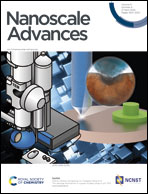The damage mechanism in copper studied using in situ TEM nanoindentation†
Abstract
Copper (Cu) has a soft-plastic nature, which makes it susceptible to damages from scratching or abrasive machining, such as lapping and polishing. It is a challenge to control these damages as the damage mechanism is elusive. Nonetheless, controlling damages is essential, especially on the atomic surfaces of Cu. To interpret the damage mechanism, in situ transmission electron microscopy (TEM) nanoindentation was performed using a cube-corner indenter with a radius of 57 nm at a loading speed of 5 nm s−1. Experimental results showed that damages originate from dislocations, evolve to stack faults, and then form broken crystallites. When the indentation depth was 45 nm at a load of 20 μN, damages comprised dislocations and stacking faults. After increasing the depth to 67 nm and load to 30 μN, the formation of broken crystallites initiated; and the critical depth was 67 nm. To validate the damage mechanism, fixed-abrasive lapping, mechanical polishing, and chemical mechanical polishing (CMP) were conducted. Firstly, a novel green CMP slurry containing silica, hydrogen peroxide, and aspartic acid was developed. After CMP, a surface roughness Ra of 0.2 nm was achieved with a scanning area of 50 μm × 50 μm; and the thickness of the damaged layer was 3.1 nm, which included a few micro-stacking faults. Lapping and mechanical polishing were carried out using a silicon carbide plate and cerium slurry, with surface roughness Ra values of 16.42 and 1.74 nm, respectively. The damaged layer of the former with a thickness of 300 nm comprised broken crystallites, dislocations, and stacking faults and that of the latter with a thickness of 33 nm involved several stacking faults. This verifies that the damage mechanism derived from in situ TEM nanoindentation is in agreement with lapping and polishing. These outcomes propose new insights into understanding the origin of damages and controlling them, as well as obtaining atomic surfaces using a novel green CMP technique for soft-plastic metals.



 Please wait while we load your content...
Please wait while we load your content...